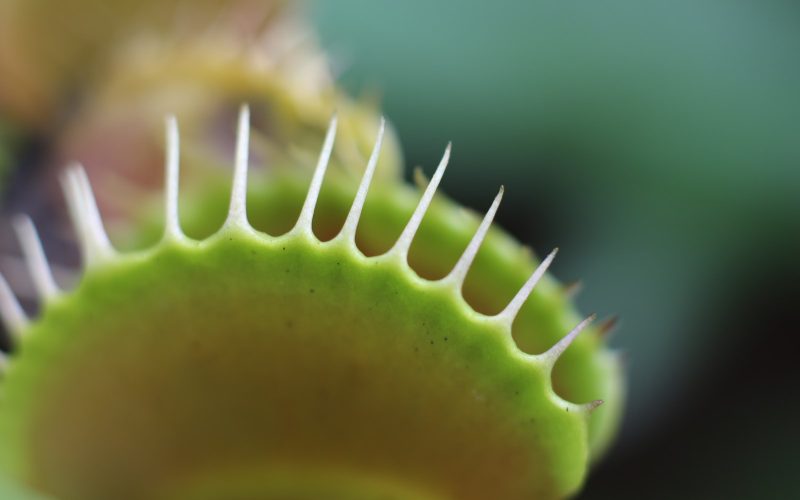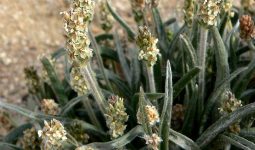Welcome to a comprehensive guide to different types of carnivorous plants. And yes, there are incredibly different types of carnivorous plants to explore.
Whether you’re a budding botanist or just curious about these intriguing plants, this guide will give you a better understanding of the different types of carnivorous plants.
So get ready to explore the fascinating world of carnivorous plants!
1. Venus Flytrap
The Venus Flytrap is one of the most iconic different types of carnivorous plants and can be easily identified due to its unique trapping mechanism.
It has several hinged leaves that are lined with sensitive trigger hairs, which, when disturbed by an unsuspecting insect, cause the leaf to snap shut.
This traps the insect inside, which the plant’s enzymes will digest. They prefer to grow in nutrient-poor soils, so they have adapted to feed on insects to supplement their diet.
Venus flytraps are native to North and South Carolina but can also be found in many other parts of the world.
2. Trigger Plants
Trigger plants are different types of carnivorous plants native to Australia and New Guinea.
This species is part of the Stylidiaceae family, and they are known for their highly specialized trap mechanisms.
Trigger plants get their name from their ability to detect the presence of prey and instantly activate a “trigger” to capture it.
The traps consist of a small mound of nectar-secreting glands surrounded by a ring of trigger hairs.
When prey lands on the mound, the trigger hairs detect the motion and respond by quickly closing the ring around it.
This allows the trigger plant to catch insects, which it then digests using enzymes effectively.
These fascinating carnivorous plants are relatively rare and require specific environmental conditions to survive, so they can be difficult to cultivate.
3. Roridula Sp.
Roridula is a genus of carnivorous plant that belongs to the Roridulaceae family and is native to the mountains of South Africa.
It is one of the most unusual types of carnivorous plants, as it cannot produce its own digestive enzymes.
Instead, it relies on arthropod prey, such as spiders and ants, to secrete enzymes that can help it to digest its food.
These plants are often found growing in well-drained, acidic soils in their native habitats, but they can also be grown in containers.
Roridula Sp. Features dark green, leathery leaves that are covered in sticky glands and long, thin stems.
This plant will attract many insects due to its strong odor and sticky glands, which makes it an excellent choice for gardeners looking to attract beneficial insects.
4. Waterwheel Plant
The Waterwheel Plant is one of the fascinating different types of carnivorous plants that is native to many parts of the world.
This plant has the unique ability to capture and digest small insects using its root-like leaves. It is unique amongst carnivorous plants as it has no leaves, instead using its root-like structures to trap its prey.
This plant species have various adaptations that make it an effective insectivore. These include specialized hairs on its roots that help trap and hold the insect and enzymes that break down its exoskeleton.
Additionally, the waterwheel plant requires very specific environmental conditions to survive. Conditions such as a shallow pool of clean water and high humidity levels are not a particularly easy species of carnivorous plant to care for.
Despite this, the waterwheel plant is an intriguing species and makes a fascinating addition to any carnivorous plant collection.
5. Sundew
The Sundew Drosera, also called the “master of sticky fly paper,” is an insect trap that traps its prey using a dense network of sticky hairs.
Digestive enzymes produced by these hairs, including proteases and phosphatases, have the tendency to destroy the trapped prey.
The common name of this plant comes from the way its leaves reflect sunlight like dew. It moves somewhat more slowly than the Venus flytrap.
6. Albany Pitcher Plant
The Albany Pitcher Plant is an Australian native plant found in the southwest corner of Western Australia.
Its scientific name is Cephalotus follicularis, and it belongs to the family of Sarraceniaceae.
It is a small, carnivorous pitcher plant with a pitcher-like leaf structure, which attracts and captures prey like ants, flies, and small insects.
The Albany Pitcher Plant has a distinct pitcher shape, traps insects, and absorbs the nutrients it needs to survive. Its leaves are usually green in color with red stripes and patterns.
These features make the Albany Pitcher Plant a unique type of carnivorous plant that should not be overlooked.
7. Cobra Lily
The cobra lily is a unique carnivorous plant that is native to the wetland habitats of California and Oregon.
Compared to the other different types of carnivorous plants, its distinctive green, yellow, and red colors make it easily recognizable in the wild. This plant grows in long tendrils that can reach up to 3 feet in length.
Its modified leaves form distinctive “cobras” that can trap and digest insects, making it a very effective hunter.
Unlike most other carnivorous plants, the cobra lily does not use a pool of water to trap its prey. Instead, it relies on its leaves’ attractive colors and specialized structures to lure in unsuspecting insects.
8. Dewy Pine
Dewy Pine is one of the different types of carnivorous plants native to Portugal, Morocco, and Spain.
It has distinctive narrow leaves that give it the appearance of a pine tree, hence its common name.
The leaves are covered in dewy droplets of nectar, which attract insects, trapping them in the sticky secretion.
The plant can capture various insects, including ants and flies. This unique feature allows the Dewy Pine to supplement its nutritional needs with prey, enabling it to survive in nutrient-poor soils.
The insect-trapping mechanism also reduces competition from other plants for resources, giving it a competitive advantage.
9. Heliamphora
Heliamphora is a genus of carnivorous plants native to South America, commonly known as marsh pitchers.
These tropical plants are perennial, featuring up to 8 inches in height and up to 12 inches in diameter.
The pitchers are modified leaves that contain fluid to capture their prey. Inside the pitchers are downward-pointing hairs that prevent the prey from escaping.
The pitcher’s lip secretes a sweet nectar-like fluid, luring insects into the pitcher. When the insect becomes trapped, digestive enzymes break down the proteins into nitrogenous compounds, which the plant can absorb.
Heliamphora is an interesting and unique one of the different types of carnivorous plants that is sure to add an exotic touch to any home or garden.
10. Butterworts
A tiny herbaceous plant native to Central and South America and Siberia, the Butterwort Pinguicula is well-known for its hummingbird-pollinated flowers.
Given that it feels greasy when touched, the Latin word “Pinguicula” literally translates as “small greasy one.”
These plants have small, sticky hairs covering their leaves, producing enzymes and acids that can dissolve and disintegrate their prey.
Above all, they are not excluded from this list of different types of carnivorous plants.
11. North American Pitcher Plant
The North American Pitcher Plant (Sarracenia sp.) is a unique carnivorous plant native to parts of the United States and Canada.
These fascinating species have adapted to survive in nutrient-poor environments by trapping and digesting insects.
The pitcher plant leaves form a tube-like structure with a waxy coating on the inner surface, attracting flying insects.
The insect then slides down the slippery tube and becomes trapped inside, where it will eventually be digested.
The plant also produces nectar which attracts more prey and helps ensure its survival.
The North American Pitcher Plant is an amazing example of how plants have adapted to survive in harsh environments.
12. Tropical Pitcher Plant
The tropical pitcher plant (Nepenthes sp.), as a species of the different types of carnivorous plants, grows in areas with tropical climates.
These plants have evolved over millions of years, and their leaves form pitchers filled with liquid, attracting insects and other small creatures. The plant slowly digests these trapped insects, providing it with the essential nutrients it needs.
The most common species of this type of plant can be found in Southeast Asia and Madagascar.
Tropical pitcher plants have long, slender stems that can grow up to 2 meters in length and produce beautiful flowers.
They prefer warm, humid climates and can be difficult to cultivate, but they are well worth the effort!
13. Attenborough’s Pitcher Plant
The Attenborough’s Pitcher Plant (Nepenthes attenboroughii) is a type of carnivorous plant native to the Philippines.
It has an attractive green and red coloration, and its pitchers can hold up to two liters of liquid! Its large size makes it a great conversation piece for any home or garden.
The plant feeds by trapping insects in its pitcher-like traps, which are filled with digestive juices that allow the plant to extract nutrients from its prey.
Attenborough’s Pitcher Plant can grow in lowland and highland conditions, making it a versatile choice for any carnivorous plant enthusiast.
We are not done yet with this list of the different types of carnivorous plants you should know. Read further!
14. Rafflesia Pitcher Plant
The Rafflesia Pitcher Plant is one of the most unusual of the different types of carnivorous plants out there.
It is native to the Malaysian rainforest and can be found in parts of Indonesia, Brunei, and the Philippines.
It gets its name from Sir Thomas Stamford Raffles, a British statesman who discovered this plant in 1818.
The plant produces pitcher-like structures which contain digestive enzymes that trap and digest insects and other prey items. The plant has a large, deep red flower that can grow up to one meter in diameter.
This species of pitcher plant is an important food source for many animals in the rainforest and helps support the local ecosystem.
15. Side-Saddle Flower
The Side-Saddle Flower (Sarracenia purpurea) is an unusual carnivorous plant that hails from North American wetlands and bogs. It has long, upright leaves with a characteristic curved hood and red veins.
The underside of the leaf is covered in tiny nectar glands that attract insects, which get trapped inside the pitcher.
Once inside, digestive enzymes and bacteria break down the prey until it is completely digested.
This unique form of carnivory allows the plant to survive in environments with limited access to nutrients.
The Side-Saddle Flower, one of the different types of carnivorous plants, is a captivating sight and an interesting addition to any garden or terrarium.
16. Yellow Pitcher Plant
The yellow pitcher plant, also known as Sarracenia Flava, is a unique and interesting carnivorous plant species that thrives in wet, boggy areas.
This species can grow up to three feet tall, with wide leaves shaped like pitchers and adorned with bright yellow coloration.
The leaves have downward-pointing bristles, allowing them to trap unsuspecting insects, which are then slowly digested by the plant’s digestive enzymes.
Because of its beauty and ease of care, this particular carnivorous plant species is very popular among gardeners.
17. Parrot Pitcher Plant
The Parrot Pitcher Plant (Sarracenia Psittacina) is a unique and distinctive carnivorous plant species.
It has large, yellow-green, funnel-shaped pitchers that are often striped or spotted. These pitchers are full of digestive juices and act as traps to attract and digest prey.
The Parrot Pitcher Plant prefers moist, acidic soil and will do best in shady areas with some indirect light.
It can grow to a foot in height and is native to parts of the eastern United States and Canada. It is one of the different types of carnivorous plants that we have on this list.
18. Veitch’s Pitcher-Plant
Veitch’s Pitcher-Plant is an unusual species of carnivorous plant. It has a vase-shaped pitcher and produces an alluring nectar to attract insects.
When they come too close, they slip down the slippery walls of the pitcher and into the digestive fluids at the bottom, where they are trapped and digested.
This unique carnivorous plant species is native to tropical islands of Southeast Asia but can also be found in some parts of India and Sri Lanka.
It grows best in moist, humid environments and needs bright light for optimal growth.
The Veitch’s Pitcher-Plant is easy to care for and maintain, making it a great choice for the beginner carnivorous plant enthusiast.
19. Byblis
Byblis is a genus of carnivorous plants belonging to the family Roridulaceae. These rare and mysterious plants have adapted to the harsh environment of their native Australia by trapping small insects and using them as an additional source of nutrients.
Byblis is not left out of this list of the different types of carnivorous plants. Further, they are relatively small, often growing less than 1 foot tall, and bear flat, bright green leaves that curl up around the edges.
Their flowers can range in color from purple to yellow and are often surprisingly fragrant. Byblis plants are extremely slow-growing, but with the right care, they can be kept healthy and even bloom.
20. Triphyophyllum Peltatum
Triphyophyllum peltatum is an unusual carnivorous plant species native to tropical regions of South America, including Ecuador and Peru.
It is a member of the family Droseraceae and is known as the shield or umbrella plant due to its large umbrella-shaped leaves.
These leaves are covered in white hairs that capture and hold tiny insects in the center.
Once captured, the plant digests the insects for nutrition, absorbing their nitrogen and phosphorus. This species is perfect for growing in humid, warm terrariums.
21. Brocchinia Reducta
Brocchinia reducta is an intriguing type of carnivorous plant native to South America.
It is a member of the Bromeliaceae family and is commonly referred to as “the poor man’s pitcher plant.” This low-growing, evergreen species has glossy green leaves that form a rosette.
The leaves can reach up to two feet in length and contain tightly packed trichomes that act as mini “pitcher traps,” trapping small insects for nutrients.
The flower stalk grows out of the center of the rosette and can reach up to five feet in height, producing bright red flowers.
This unusual carnivorous plant is easy to maintain and adds greatly to any garden.
22. Jungle Lantern
The Jungle Lantern is an unusual-looking yet beautiful carnivorous plant. Native to the tropical and subtropical areas of Central and South America, this plant is well known for its bright yellow flowers.
Its leaves have a strange, almost alien-like appearance, and when the sun comes out, it can trap insects with sticky tentacles.
It has adapted to survive in difficult terrain, thriving in humid rainforests, rocky hillsides, and dry sandy areas.
This interesting plant makes an interesting addition to any carnivorous garden. Uniquely, it is one of the different types of carnivorous plants.
23. Genlisea Sp.
This is the last on our list of different types of carnivorous plants. Genlisea Sp., also known as ‘corkscrew plants,’ is unique among carnivorous plants in that they live submerged in wet soils.
These plants have an interesting corkscrew shape and bear a few small flowers in shades of white, pink, or yellow.
Genlisea Sp. Feed mainly on small animals like protozoa and worms by trapping them in their hollowed-out leaves.
They excrete a sticky substance that attracts prey, after which the plants quickly close in and digest them.
Genlisea Sp. are not difficult to cultivate as long as they are kept in wet soil and away from direct sunlight.
Conclusion
Are you looking to add something unique and unusual to your garden? Then these different types of carnivorous plants might be the perfect choice for you!
Carnivorous plants are a fascinating and diverse group of plants with unique characteristics and traits.
Here we provide a comprehensive guide to different types of carnivorous plants. This will help you learn more about them and decide which is right for your garden. All the best!








